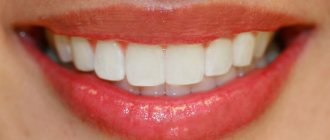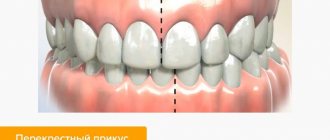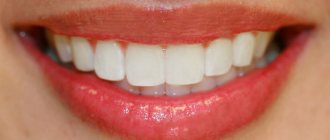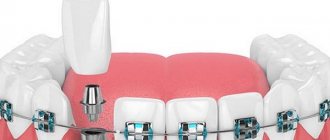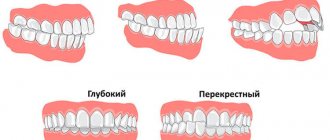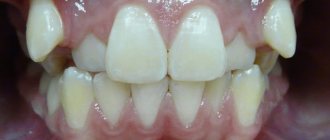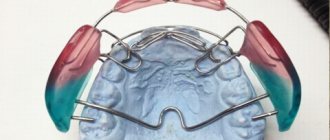The position of the teeth with the jaws closed is called a bite in dentistry. Unfortunately, not every one of us can boast of perfectly straight teeth. Most people experience malocclusion. Most often, they are small and few people notice them, but there are situations when the malocclusion is pronounced and causes a lot of inconvenience. In these cases, it is customary to install braces. What to do if for some reason it is impossible to install braces? Dentistry has developed methods for correcting malocclusion using prosthetics, but doctors warn that they can only be used in specific clinical cases, strictly according to indications.
How is the bite formed?
The process of bite formation is long - from birth to adolescence. There are 5 periods.
- Initial (up to 6 months): no teeth, the upper jaw is larger in size than the lower jaw. At this time, an active feeding process is extremely important for the proper development of the jaw apparatus.
- Emerging temporary bite (6 months - 3 years): baby teeth and a bite appear, but it is still temporary. This stage is accompanied by inflammation of the gums, a rise in temperature, often grinding of teeth (bruxism), and emerging teeth may be crooked. It is important to maintain hygiene without taking any orthodontic measures.
- Formed temporary occlusion (3 - 6 years): baby teeth have erupted and can close in different ways, jaw growth continues. This is the time of active use of teeth. Characteristic wear of temporary teeth is considered normal before the upcoming change.
- Changeable dentition (6-12 years): jaw growth, loss of baby teeth and appearance of permanent teeth. Often new teeth, especially the lower ones, erupt unevenly. During this period, it is necessary to decide on a plan for further correction of the bite.
- Permanent dentition (12 - 15 years): replacement of milk teeth with permanent ones, all 28 teeth are visible, no wisdom teeth. The period is most favorable for orthodontic treatment.
In order for the bite to form correctly, there must be careful attention to teething, oral hygiene, and a timely plan to correct emerging problems.
Correct teeth bite
An ideal orthognathic bite implies the presence of the following features:
- The upper dental arch is slightly inclined forward and has the shape of a semi-ellipse, the lower, in the shape of a parabola, is slightly backward.
- When the jaws close, each upper tooth contacts the opposite tooth below.
- There are no obvious gaps between the teeth.
- The upper teeth overlap the lower teeth by about a third of their height.
Despite the fact that there are the above parameters for a perfect smile, the question “What should be the bite of the teeth?” cannot be answered unambiguously. In addition to the orthognathic bite, modern orthodontics allows for several options for the normal structure of the dentition and the location of the jaws.
Orthognathic
The upper row of teeth overlaps the lower one by 30% of the height, there are no gaps between the teeth or spaces between the rows.
Biprognathic
The dentition is slightly directed towards the vestibule of the mouth.
Progenic
The lower jaw moves forward slightly.
Straight
When the jaws close, the upper teeth come into contact with the lower cutting edges.
Measurement methods
Anatomical method
The use of this method of measuring bite height is aimed at identifying the physiological transformation of the lower part of the facial zone.
Calculation of central occlusion using this method is based on identifying features of facial anatomy.
A decrease in bite height is expressed in the following points:
- sunken lips;
- increasing the depth of nasolabial folds;
- moving the chin forward;
- reduction in the height of the lower part of the face.
When using the anatomical method, you need to pay attention to the following points:
- the lips should be mobile and in contact with each other along the entire length without effort;
- the functionality of the orbicularis oris muscle should be high;
- The elevation of the corners of the mouth and the severity of the nasolabial folds should be determined.
Experts in the field of dentistry note that this research method is quite subjective , so it is practically not used at present.
Information content of teleroentgenograms in orthodontics in lateral and direct projection.
This material is devoted to modern diagnostic methods in dentistry.
Here https://orto-info.ru/ortodonticheskoe-lechenie/podgotovitelnyiy-period/miogimnastika.html we’ll talk about the effectiveness of myogymnastics in orthodontics.
Anatomical and physiological
The anatomical and physiological method for determining the height of the bite is based on identifying the height of physiological rest.
The technique for performing the procedure is as follows:
- The dentist places two marks on the patient's skin - at the base of the nasal septum and in the central part of the chin.
- Next, the patient is asked to make a couple of swallowing movements or pronounce several phrases, the pronunciation of which involves the lips.
After completing these actions, the lower jaw row comes to a state of rest. At the same time, the lips touch each other without tension, without stretching or sinking, and the nasolabial folds are moderately visible. - The dentist, using a special ruler with divisions, measures the distance between two points that were previously applied to the patient’s skin.
- Special templates with occlusal ridges are placed in the patient’s oral cavity, which must be lightly bitten.
- The specialist re-measures the distance between the points located on the nose and chin. The resulting indicator determines the occlusal height, which normally should be less than the previously determined height of physiological rest by 2-3 mm.
If, when determining the height of the bite, the occlusal height is equal to the indicator determined at rest, then the specialist concludes that the bite is elevated. Conversely, when the occlusal distance exceeds the resting height by more than 3-4 mm, this indicates an underbite.
After determining the bite index, the specialist removes or increases the height of the lower bite ridge until the occlusal height reaches the norm.
In this case, the dentist evaluates the condition of the tissues around the mouth. When the physiological occlusion is restored, the contours of the lower part of the face are normalized, the corners of the mouth are raised, and the nasolabial folds become less pronounced.
Malocclusion of teeth
Look at your reflection in the mirror. If you notice an excessively protruding upper or lower lip, teeth that “overlap” each other, or gaps between the dentition when the jaws are closed, this is a clear reason to consult a specialist. Descriptions of dental anomalies and photographs of teeth with malocclusion pathologies are presented in the table below.
Distal (prognathic)
In a distal bite, the upper jaw is more developed than the lower jaw.
Mesial (medial)
With a mesial bite, the lower jaw is pushed forward.
Cross
In a crossbite, the rows of teeth intersect in the manner of scissors when the jaws close.
Deep
In a deep bite, the upper teeth significantly overlap the lower teeth.
Open
The presence of pronounced gaps between the dentition when the jaws are closed indicates an open bite.
What types are there?
There are temporary and permanent bites. The bite in children before the eruption of permanent teeth is called temporary. 6-9 years – time of replacement bite. During this period, the child has simultaneous presence of permanent teeth and milk teeth.
Peculiarities of eruption influence the formation of the maxillofacial system. Any removal of replacement teeth earlier than a year before natural loss causes the risk of various deformities:
- asymmetrical dentition;
- midline shift;
- blocking chewing movements of the jaw.
A permanent bite is formed when a teenager reaches 15 years of age, when the formation of roots in relation to the position of the teeth ends. Their number during this period is 28 (32 - if the third molars have erupted).
Permanent dentition can be physiological or abnormal.
Physiological
photo: this is what a correct bite looks like from the side
Physiological ones include types of occlusions that provide:
- the most efficient and comfortable chewing of food;
- correct speech formation;
- aesthetic appearance of the maxillofacial area.
There are several varieties:
- Orthognathic. This is the standard bite that provides maximum functionality of the jaws. Premolars and molars intersect with antagonists of the opposite row. The upper incisors and canines overlap the lower ones due to a slight outward slope.
- Straight. It differs from orthognathic in the type of closure of the incisors. The edges of the upper ones do not overlap the lower ones, but touch end to end. The molars have good tight contact. A big disadvantage is the rapid wear of the upper and lower incisors due to contact of the cutting edges.
- Progenic . The lower jaw is pushed forward. The dental arches close tightly, the chewing function of the jaw is preserved.
- Biprognathic. The incisors and canines have a greater angle of inclination forward than with orthognathic. The contact of the anterior teeth is good. The incisors meet at the edges.
- Opisthognathic . The upper and lower incisors are inclined towards the oral cavity. The molars and premolars are tightly closed.
Abnormal
photo: malocclusion
Malocclusion is characterized by a complete or partial absence of tooth contact in occlusion. Such a bite distorts the face, disrupts the chewing process and can affect the formation of speech defects.
There are several types of abnormal bite:
- Deep. Its peculiarity is that the upper incisors overlap the antagonists by more than a third. The wear of the cutting edge is increased, causing the masticatory muscles to experience hypertonicity. This type of bite is also determined by constant sensations of tension in the temporomandibular joint and headaches.
- Open. A rather complex defect that entails disruption of several body systems at once. With the open type, some teeth do not have contact with the antagonists. There are lateral and frontal types.
Symptoms indicating the presence of an open bite are elongation of the mandibular part of the face, constant tension of the facial muscles, speech disturbances, difficulty swallowing, discomfort when chewing.This type may have a rachitic and traumatic origin. The rachitic variety is difficult to correct and usually requires surgical intervention. The traumatic variety is formed in childhood as a result of bad habits or trauma; at a young age it is quite easy to correct.
- Cross. The displacement of the lower jaw to one side forms a noticeable asymmetry of the face, the dentitions close like scissors crosswise.
A person with such a defect has difficulty chewing food and chews only on one side. Poorly chopped food provokes stomach diseases, discomfort in the jaw joint during eating, and the development of periodontal diseases. - Distal. The defect is formed as a result of good development of the upper jaw and at the same time underdevelopment of the lower jaw.
With this anomaly, the upper incisors stick out forward, leaving a large gap between the upper and lower incisors. In the formation of such an anomaly, heredity, poor posture, and removal of baby teeth (more than a year before the appearance of permanent teeth) become decisive. - Mesial . Characterized by a protracted lower jaw. With such a defect, the chin protrudes strongly and the facial profile is curved. The lower teeth are located in front of the upper teeth during occlusion.
Bite in the absence of teeth
A person without teeth has problems with the functioning of the temporomandibular joints, facial aesthetics deteriorate, and wrinkles appear due to loss of skin tone. To avoid unpleasant consequences, it is necessary to restore the bite using a complete denture made using a special technique.
Bite restoration with complete dentures
- The central ratio of the jaws is determined - the position of the lower jaw in relation to the upper in three planes: vertical, sagittal and transversal. The role of the dentition is played by wax rollers.
- Measurements are taken using a device consisting of an external facebow-ruler and an intraoral plate with a flat frontal part and curved distal parts.
- The plaster model marks the boundaries of the future structure, the line of the middle of the alveolar process, the tubercles of the upper and lower jaw, and the midline.
- Artificial teeth are placed in such a way that when you smile, the part of the prosthesis that imitates the gum is not visible.
Partial or complete orthodontic treatment?
We offer different options. Sometimes full orthodontic treatment is necessary for an aesthetic and functional result. If we are talking about patients who already have quite a lot of orthopedic structures on the upper jaw, there are no lateral teeth, there is crowding, a close position of the front incisors on the lower jaw, then it will be sufficient to align the lower incisors and, as far as possible, raise the bite. In this case, we are talking about partial orthodontic treatment, lasting not 1.5-2 years, but much faster.
Local problems, such as tilted eighth teeth in the absence of seventh or sixth teeth, are solved by the support of two miniscrews without the use of a brace system or by using small systems for the lateral group of teeth. This will also be partial orthodontic treatment.
Bite after wisdom tooth removal
Some doctors are convinced that wisdom teeth are an atavism and must be gotten rid of. In ancient times, they were used to chew tough foods, such as raw meat. With the development of civilization, the human diet changed, his jaw began to gradually decrease - and the “eights” turned out to be superfluous. Most often, before starting to correct the bite, wisdom teeth are removed. This frees up space for the correct formation of rows, and the result of teeth alignment will be much better.
What affects the bite of teeth?
The negative impact of defects in the dental system on the condition of the entire organism has been repeatedly proven by scientists. The list of identified health risks is impressive even for ardent optimists.
- Due to improper distribution of the chewing load, tooth enamel wears off faster, teeth begin to react painfully to cold and hot, their necks become exposed, and noticeable gaps form between the teeth.
- Diseases of the temporomandibular joints occur, accompanied by headaches and a characteristic clicking sound when the jaws move.
- The aesthetics of the face suffers: its proportions change, wrinkles form, teeth become crooked, and the smile becomes unattractive.
- It becomes difficult to bite food, chewing functions are disrupted, causing diseases of the gastrointestinal tract.
- Speech defects appear, facial expressions are distorted, and self-esteem decreases.
- Crowding and crooked teeth cause accelerated tooth decay due to frequent chipping and carious lesions.
- The oral mucosa is injured - cheeks, gums, tongue, and the tissues of the oral cavity become inflamed.
- The quality of breathing deteriorates, which leads to diseases of the nasopharynx, trachea, and hearing aid.
Treatment of dental malocclusion
How to change the bite of teeth? Pathologies of the dental system can only be eliminated through orthodontic treatment. An exception is the correction of a low bite, when the height of the teeth decreases with age due to their wear. In such cases, the bite is corrected by dental prosthetics with crowns or veneers, as well as by implantation. Other anomalies of teeth and bite can be removed at any age with special orthodontic structures or through surgical intervention.
However, maxillofacial operations are performed only in case of serious deviations from the norm. Usually, to correct dental malocclusion, doctors suggest correction with braces or aligners.
Now that you know about all the health risks that can cause pathologies of the dental system, and how to correct your dental bite, all that remains is to take specific actions. Even if at first glance it seems that your teeth are straight, make an appointment with an orthodontist. Diagnosing the condition of the dentition will help maintain the health of other organs and systems. And timely orthodontic treatment will make your smile more attractive and significantly reduce the number of future visits to the dentist.
Correction of the smile zone and missing anterior incisors
There is an aesthetic problem in the smile area associated with the absence of front teeth, for example, second incisors. Nowadays, it is not uncommon that even their rudiments are missing. It does not cause complaints as long as there are baby teeth in this place, but after their removal the question arises about restoring the defect. In such situations, the orthodontist, orthopedist and implantologist choose a comprehensive treatment strategy. Options are being considered with implantation and prosthetics in this area or orthodontic movement of adjacent teeth with their further restoration with veneers to create a harmonious smile.
A less common situation is the absence of one of the front incisors. If the defect has existed for quite a long time, then problems may arise with implantation in this area due to a lack of bone tissue. Then the orthodontist proposes a treatment plan with moving the lateral incisor to the place of the missing central one, and prosthetics on the implant is carried out in the freed area where there is enough bone tissue.



